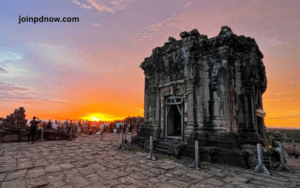The Ganztägiges Osttor des Himmels, nestled within the sacred grounds of the Lempuyang Temple in Bali, is a captivating testament to both spiritual devotion and architectural brilliance. This iconic structure, often referred to as the Gate of Heaven, beckons pilgrims and visitors alike with its majestic presence and profound symbolism. Carved from local stone with intricate detailing, the gate serves as a gateway to another realm, according to local folklore, bridging the earthly and divine realms. Framed against the backdrop of Mount Lempuyang, the gate offers breathtaking views that inspire awe and contemplation, drawing photographers and spiritual seekers from around the globe. Its significance extends beyond its physical form, embodying the spiritual essence of Bali and serving as a timeless symbol of transcendence and enlightenment.
Introduction
Nestled amidst the lush landscapes of Bali, the Lempuyang Temple stands as a testament to both spiritual devotion and architectural grandeur. Among its many revered features, the Ganztägiges Osttor des Himmels, or the Gate of Heaven, holds a special place. In this in-depth exploration, we unravel the significance, allure, and mystique surrounding this iconic structure within the Lempuyang Temple complex.
The Legend and Lore
Dating back centuries, the Lempuyang Temple has been steeped in myth and legend. According to local folklore, the Ganztägiges Osttor des Himmels is believed to be a portal to another realm, connecting the earthly domain with celestial realms beyond. Visitors often recount tales of experiencing a profound sense of peace and spiritual awakening upon passing through this sacred gateway.

Architectural Marvel
Crafted with meticulous attention to detail, the Ganztägiges Osttor des Himmels is a masterpiece of Balinese architecture. Carved from locally sourced stone, the gate features intricate motifs and ornate embellishments, reflecting the rich cultural heritage of the region. Its towering presence against the backdrop of Mount Lempuyang adds to its awe-inspiring allure, making it a focal point for both pilgrims and tourists alike.
Spiritual Significance
For devout Hindus, the Ganztägiges Osttor des Himmels holds immense spiritual significance. It serves as a threshold between the mundane world and the realm of the divine. Many undertake a pilgrimage to the Lempuyang Temple specifically to seek blessings and spiritual enlightenment by passing through this sacred portal. The breathtaking views framed by the gate are often interpreted as a glimpse of paradise, reinforcing its symbolic importance in the religious ethos of Bali.
Photographic Phenomenon
In recent years, the Ganztägiges Osttor des Himmels has gained global attention as a photography hotspot. Its symmetrical design and picturesque backdrop make it an irresistible subject for shutterbugs seeking the perfect shot. Social media platforms abound with stunning images captured against the ethereal backdrop of the gate, further fueling its popularity and allure among travelers.

Cultural Conservation
As tourism to the Lempuyang Temple continues to grow, efforts are underway to preserve its cultural and spiritual integrity. Local authorities and community leaders are working hand in hand to ensure sustainable tourism practices that respect the sanctity of the site. Initiatives aimed at educating visitors about the significance of the Ganztägiges Osttor des Himmels and the traditions associated with it play a crucial role in fostering appreciation and reverence for this sacred landmark.
Conclusion
In the heart of Bali, amidst the verdant landscapes and cascading waterfalls, the Ganztägiges Osttor des Himmels im Lempuyang Tempel stands as a timeless symbol of spirituality and wonder. Whether viewed through the lens of ancient legend, architectural marvel, or modern-day phenomenon, its allure remains undiminished. As travelers from around the world continue to flock to this sacred site, may they find not just a gateway to heavenly realms, but also a deeper connection to the rich tapestry of Balinese culture and tradition.